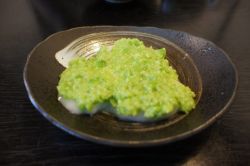
Originally published on metropolis.co.jp on October 2012

The unclassifiable electronic composer Amon Tobin will be putting on Isam Live, the “immersive A/V show” that has garnered plaudits round the world, at Beatink’s giant rave in November. Ahead of the visit, Metropolis caught the Brazilian-born, UK-raised virtuoso on the phone.
People find it hard to characterize you. How would you characterize yourself?
I don’t really have to fortunately, I just make the music and people such as yourselves have that job.
How do you feel about your previous records when you move in a new direction?
I see it all as part of one process. When I first started out people focused on the material I was using and that distracted from what I was trying to do, which was to see what happened if you took something out of context. To take a genre like jazz and put it in electronic music, in a way the musician never intended. It wasn’t anything to do with jazz, but to do with displacement. That was what sampling was about. And from that starting point I went further and manipulated the sound, changed its texture, its timbre, its tone, and pitch, and changed the sound itself through processing. Now it’s been to recreate sounds—guitars and strings, percussion elements—from things in the natural world that might have similar properties, building a synthesized instrument, and putting it back into an electronic setting. But it’s still taking things out of context, doing the same thing. Making my own understanding of the world.
Is there something you feel most proud of?
This Isam record is my very proudest moment. It was the closest I have got to something I imagined and that was an achievement. And it really did break some ground, maybe in ways too nuanced for people to know about. But for me, and for those who know about production, it did things that have never been done before, so it feels like a contribution. It feels like I’ve done something to be part of something bigger.
You used all kinds of your own recorded sounds in Isam. What is it in a noise that catches your attention?
I’ll have a pretty clear idea of a sound or instrument I want to make, and I’ll go out and find specific elements that make up the sound. I made a surf guitar out of wasps and a Harley Davidson. When you try and make a render of something, whether it’s a painting or computer rendering or a synthesis of sound, you have to look at the object very carefully so you can replicate it. Take a snare drum for example. What it really is a resonant chamber with skin across it and a spring underneath. The question is: why don’t you just use a drum or a guitar? Well, once you’ve made a virtual version, you can make it do impossible things that the physical object can’t do. My drum has the physical properties of a snare drum but I can make the resonant chamber 50 feet wide. I can make the skin out of a totally different material.
Are you voracious about other music?
I’m always curious about how people make their sounds. I listen a lot. I’m always trying to understand the sounds, the composition. I like really well made, simple pop music. So I try to listen to that stuff and work out why I like it, why not, why it resonates so strongly. The stuff I make is structurally quite simple and I try to keep it from being abstract or noodling away endlessly. I really do like structure. The things my sounds are made of are more complicated, but musically it’s more of a pop sensibility.
Is anyone better than you?
No. [Laughs]







